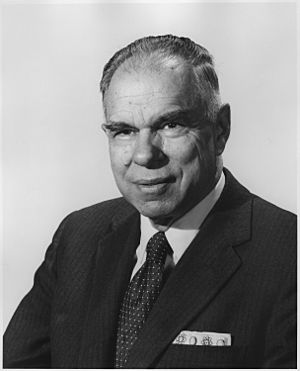Seaborgium facts for kids
| Seaborgium | |||||||||||||||||||||||||||||||||||
|---|---|---|---|---|---|---|---|---|---|---|---|---|---|---|---|---|---|---|---|---|---|---|---|---|---|---|---|---|---|---|---|---|---|---|---|
| Pronunciation | |||||||||||||||||||||||||||||||||||
| Mass number | 269 | ||||||||||||||||||||||||||||||||||
| Seaborgium in the periodic table | |||||||||||||||||||||||||||||||||||
|
|||||||||||||||||||||||||||||||||||
| Atomic number (Z) | 106 | ||||||||||||||||||||||||||||||||||
| Group | group 6 | ||||||||||||||||||||||||||||||||||
| Period | period 7 | ||||||||||||||||||||||||||||||||||
| Block | d | ||||||||||||||||||||||||||||||||||
| Electron configuration | [Rn] 5f14 6d4 7s2 | ||||||||||||||||||||||||||||||||||
| Electrons per shell | 2, 8, 18, 32, 32, 12, 2 | ||||||||||||||||||||||||||||||||||
| Physical properties | |||||||||||||||||||||||||||||||||||
| Phase at STP | solid (predicted) | ||||||||||||||||||||||||||||||||||
| Density (near r.t.) | 35.0 g/cm3 (predicted) | ||||||||||||||||||||||||||||||||||
| Atomic properties | |||||||||||||||||||||||||||||||||||
| Oxidation states | 0, (+3), (+4), (+5), +6 (parenthesized: prediction) | ||||||||||||||||||||||||||||||||||
| Ionization energies |
|
||||||||||||||||||||||||||||||||||
| Atomic radius | empirical: 132 pm (predicted) | ||||||||||||||||||||||||||||||||||
| Covalent radius | 143 pm (estimated) | ||||||||||||||||||||||||||||||||||
| Other properties | |||||||||||||||||||||||||||||||||||
| Natural occurrence | synthetic | ||||||||||||||||||||||||||||||||||
| Crystal structure | body-centered cubic (bcc)
(predicted) |
||||||||||||||||||||||||||||||||||
| CAS Number | 54038-81-2 | ||||||||||||||||||||||||||||||||||
| History | |||||||||||||||||||||||||||||||||||
| Naming | after Glenn T. Seaborg | ||||||||||||||||||||||||||||||||||
| Discovery | Lawrence Berkeley National Laboratory (1974) | ||||||||||||||||||||||||||||||||||
| Main isotopes of seaborgium | |||||||||||||||||||||||||||||||||||
|
|||||||||||||||||||||||||||||||||||
Seaborgium is a special kind of chemical element. It has the symbol Sg and its atomic number is 106. This means it has 106 protons in its center.
Seaborgium is a radioactive element. This means it gives off energy as it changes over time. It doesn't exist naturally on Earth. Scientists have to make it in a lab.
We don't know what Seaborgium looks like. This is because only tiny amounts have ever been made. Not enough to see with our eyes! But because it's in the same group as Tungsten on the Periodic Table, it might look similar to Tungsten.
Contents
What is Seaborgium?
Seaborgium is a transuranium element. This is a fancy way of saying it's an element that comes "after" Uranium on the Periodic Table. Uranium is element number 92, so any element with a higher atomic number is called transuranium.
How Scientists Predicted Seaborgium
Long ago, a scientist named Dmitri Mendeleev thought that an element like Seaborgium would exist. He was famous for creating the Periodic Table. He called this predicted element eka-tungsten. He gave it this name because he thought it would be very similar to Tungsten. Scientists have found that the way Seaborgium acts chemically is indeed a lot like Tungsten.
Naming Seaborgium

This element is named after a famous American scientist, Glenn Seaborg. He was a very important person in the world of chemistry. He helped discover many new elements that don't exist in nature. Naming an element after him was a way to honor his amazing work.
Seaborgium's Short Life
The most stable type of Seaborgium is called 271Sg. This number tells us how many protons and neutrons are in its center. This type of Seaborgium has a very short half-life of only 2.4 minutes. A half-life is the time it takes for half of a radioactive substance to change into something else. Because its half-life is so short, it's very hard to study Seaborgium.
Images for kids
-
Element 106 was named after Glenn T. Seaborg, a pioneer in the discovery of synthetic elements, with the name seaborgium (Sg).
See also
 In Spanish: Seaborgio para niños
In Spanish: Seaborgio para niños




